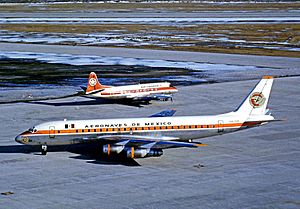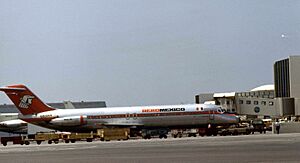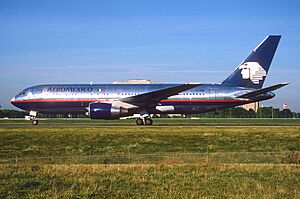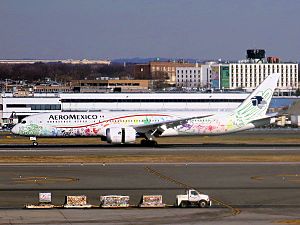Aeroméxico facts for kids
| Founded | 14 September 1934 (as Aeronaves de México S.A. de C.V.) |
|---|---|
| Commenced operations |
|
| AOC # | ASMF152F |
| Hubs | Mexico City |
| Secondary hubs |
|
| Frequent-flyer program | Aeroméxico Rewards |
| Alliance | SkyTeam/SkyTeam Cargo |
| Subsidiaries |
|
| Fleet size | 125 |
| Destinations | 100 |
| Parent company | Grupo Aeroméxico |
| Headquarters | Torre MAPFRE, Mexico City, Mexico |
| Key people | Andrés Conesa Labastida (CEO) |
| Revenue | |
| Net income | |
| Employees | 13,880 (2023) |
Aeroméxico is the main airline of Mexico. It is based in Mexico City. Aeroméxico flies to over 90 places in Mexico, North, South, and Central America, the Caribbean, Europe, and Asia. Its main airport is Mexico City International Airport. It also has important bases in Guadalajara and Monterrey. The airline's main office is in the Torre MAPFRE building in Mexico City.
Aeroméxico is part of Grupo Aeroméxico. This group also includes Aeroméxico Connect, which is a regional airline. Aeroméxico is a founding member of the SkyTeam airline alliance. Other founding members include Air France, Delta Air Lines, and Korean Air.
Aeroméxico works closely with Delta Air Lines, an airline from the U.S. Delta owns a part of Aeroméxico. In 2017, they started a special agreement. This agreement helps them share information, costs, and money from flights between the United States and Mexico.
In 2016, Aeroméxico carried almost 20 million passengers. This included both flights within Mexico and international flights.
Contents
- History of Aeroméxico
- Aeroméxico's Business
- Where Aeroméxico Flies
- Aeroméxico's Planes
- Important Events and Incidents
- See also
History of Aeroméxico
| Timeline | |
|---|---|
| 1930s | |
| 1934 | Established as Aeronaves de México. Maiden flight is Mexico City–Acapulco in Stinson Reliant SR-5A |
| 1940s | |
| Grew with help of Pan Am, 25% owner | |
| 1950s | |
| Takes over #2 Aerovías Guest thus adding routes to Madrid, Paris. Added DC-3s, DC-4s, pressurized Douglas DC-6s, 2 Bristol Britannia turboprops. | |
| 1958 | Service begins to New York with Britannias |
| 1959 | Nationalized |
| 1960s | |
| 1961 | First jets, Douglas DC-8s |
| 1962 | Merged Aerovías Guest into Aeroméxico |
| Late 1960s | Service to Europe re-initiated with Comet-4Cs formerly of Guest |
| 1970s | |
| 1970 | Governments nationalizes all 9 Mexican airlines into integrated system under control of Aeronaves de México |
| 1972 | Commercial name changed to Aeroméxico |
| 1974 | Receives first Douglas DC-10-30 and DC-9-32s |
| 1980s | |
| 1986 | Cerritos mid-air collision |
| 1988 | Privatization starts |
| 1990s | |
| Early 1990s | Fare wars with other private airlines |
| 1992 | Acquires Aeroperú |
| 1993 | Acquires Mexicana |
| 1994 | Mexican peso crisis |
| 1996 | Government control again: Cintra created holding Mexicana and Aeroméxico |
| 2000s | |
| 2000 | Founds SkyTeam alliance with Air France, Delta Air Lines and Korean Air |
| 2006 | Flights start to Tokyo |
| 2007 | Privatization. Banamex purchases for $249 million USD. |
| 2008 | Service to Shanghai begins |
| 2010 | Mexicana goes bankrupt |
| 2010s | |
| 2011 | Cooperation agreement with Delta Air Lines |
| 2013 | First Boeing Dreamliner 787-8s delivered |
| 2014 | Delta-Aeromexico Querétaro TechOps opens |
| 2016 | First Boeing Dreamliner 787-9s delivered named Quetzalcóatl. WiFi introduced on-board. New website, check-in kiosks and chatbot launched. |
| 2017 | Antitrust immunity with Delta Air Lines and beginning of Joint Commercial Agreement (JCA) covering all US-Mexico routes. Service to Seoul begins. |
| 2018 | Aeroméxico Connect Flight 2431 plane crash on runway. |
How it Started: 1934
The airline began on September 15, 1934. It was first called Aeronaves de México. Antonio Díaz Lombardo started the company. Its first plane was a Stinson SR Reliant 5A. The first flight was on September 14, 1934. It flew from Mexico City to Acapulco.
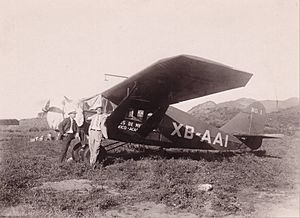
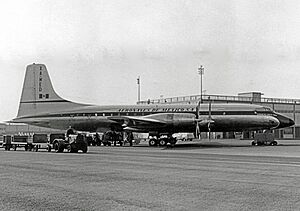
Growth in the 1940s and 1950s
During World War II, the airline grew with help from Pan Am. Pan Am owned 40% of the airline. The fleet was updated with DC-2s and Boeing 247s. In the 1950s, the airline bought smaller airlines. This included Aerovías Guest, which flew to Madrid and Paris. Aeroméxico added planes like the Douglas DC-3 and Douglas DC-4.
Later in the 1950s, Douglas DC-6s and Bristol Britannias were added. The Britannias were the first turboprop planes in the fleet. In 1958, flights to Idlewild Airport (now JFK) began. The Mexico City to New York route became very popular. In 1959, the airline became owned by the government.
New Jets in the 1960s
In the early 1960s, Aeronaves de México used Douglas DC-3, DC-6, and Bristol Britannia planes. In 1961, the airline started using jet planes. The first jets were Douglas DC-8s. These jets flew routes within Mexico and to New York City. In 1963, Aeronaves de México took over Aerovias Guest. The two airlines merged under the name Aeronaves de México. More DC-8s were added later. Flights to Europe started again using de Havilland Comet 4C jets.
Changes in the 1970s
The 1970s brought big changes. In 1970, the Mexican government took control of domestic airlines. Aeronaves de México became the main part of this new system. The older Douglas DC-6 and Bristol Britannia planes were retired. The airline also got a new orange and black color scheme. In February 1972, its name changed from "Aeronaves de México" to the shorter "Aeroméxico."
Aeroméxico was one of the first airlines to order the McDonnell Douglas DC-10-30. It received its first DC-10 in 1974. That same year, it also got its first McDonnell Douglas DC-9-32s.
During this time, Aeroméxico became very well known. This was partly because the airline was often shown in Mexican movies.
Expansion and Challenges in the 1980s
The early 1980s were a time of growth for Aeroméxico. The airline got a new orange and silver color scheme. It added two DC-10-15s and a DC-10-30. Aeroméxico was also one of the first airlines to use the McDonnell Douglas MD-82. It received its first two MD-82s in late 1981. Eight more DC-9-32 planes were added between 1980 and 1981.
On August 31, 1986, Aeroméxico Flight 498, a Douglas DC-9, was approaching Los Angeles International Airport. It collided with a small plane. Both planes crashed in Cerritos, California. Everyone on both planes died, along with 15 people on the ground. After an investigation, the airline and its crew were found not to be at fault. The pilot of the small plane had flown into an area meant for commercial flights.
In April 1988, the government-owned company faced financial problems. It stopped flying for three months. In August, a plan began to make it a private company again. This plan included getting rid of the older Douglas DC-8s and DC-9-15 planes. After a strike and bankruptcy, the airline restarted operations. It had a new name: Aerovias de Mexico SA de CV. It kept some of its old buildings, planes, and employees.
The 1990s: New Planes and Economic Troubles
The early 1990s were difficult. Fuel costs went up because of the Gulf War. New airlines in Mexico also caused a price war. In April 1991, Aeroméxico added its first two Boeing 767-200ERs. These planes replaced DC-10s on flights to Europe, New York, and Tijuana. Later that year, two more 767-300ERs joined the fleet. This was part of a plan to add many direct flights to Madrid and Paris from Mexico City.
In 1992, Grupo Aeroméxico tried to buy Continental Airlines but it did not happen. After that, Aeroméxico bought the airline Aeroperú from the government of Peru.
In 1993, Aeroméxico Group also took over Mexicana. Mexicana was the second-largest airline in Mexico. Between 1994 and 1995, the six DC-10 planes in the fleet were retired.
In December 1994, Mexico faced an economic crisis. Aeroméxico had to cut flights and return some planes. Flights to Frankfurt and Rome were canceled. Flights to Madrid and Paris were then only flown by two Boeing 767-300ER jets.
In 1996, a company called Cintra was created. Its goal was to prevent Aeroméxico and Mexicana from going bankrupt. The airline started to recover between 1996 and 1998. It leased back some McDonnell Douglas MD80s and Boeing 767-200ERs.
Plans to sell Grupo Cintra were delayed. Then, the 11 September 2001 attacks happened. This caused big problems for airlines, and the sale did not happen.
The 2000s: New Planes and Alliances

Between 2000 and 2005, Aeroméxico had about 60 planes. On June 22, 2000, Aeroméxico helped start the SkyTeam global airline alliance. Other founding members were Air France, Delta, and Korean Air. After the 9/11 attacks, the airline started updating its fleet. In 2003, it bought its first Boeing 737-700 planes. These replaced its older DC-9 aircraft.
On March 29, 2006, Aeroméxico started direct flights between Japan and Mexico City. These flights stopped in Tijuana. This happened after the airline bought two Boeing 777-200ERs. This made Aeroméxico one of the few airlines in Latin America to fly regularly to Asia. Aeroméxico restarted its Mexico City-Tijuana-Shanghai route in March 2010. This flight had been stopped because of the 2009 flu pandemic.
In June 2006, Aeroméxico announced it would operate three Boeing 787 Dreamliners. Deliveries were planned to start in 2012. In 2007, Aeroméxico was sold to Grupo Financiero Banamex for US$249.1 million. In October 2010, Aeroméxico's biggest competitor, Mexicana de Aviacion, went bankrupt.
The 2010s: Delta Partnership and Dreamliners
Working with Delta Air Lines
In 2011, Delta Air Lines and Aeroméxico made a stronger business agreement. Delta invested US$65 million in Aeroméxico shares. Delta also got a seat on Aeroméxico's board of directors.
- In March 2014, the airlines opened Tech Ops Mexico. This was a US$55 million joint facility for plane maintenance in Queretaro City, Mexico.
- In March 2015, the airlines asked for special permission to work together more closely. This would allow them to share costs and profits on all Mexico–U.S. flights.
- In May 2017, this joint agreement officially started. The airlines now share information and decide together on routes and prices for all flights between the U.S. and Mexico. They also share costs and profits.
Dreamliner Planes
On July 25, 2012, Aeroméxico announced it would buy six Boeing 787-9 Dreamliners. This was in addition to 20 planes announced in 2011 and nine Boeing 787-8 Dreamliners already planned. The Dreamliners started arriving in the summer of 2013. The total investment was US$11 billion. It also included 90 Boeing 737 MAX 8s, which started arriving in 2018. The first Boeing 787-8 Dreamliner began flying for Aeroméxico on October 1, 2013.
In September 2016, Aeroméxico received its first Boeing 787-9 Dreamliner. This plane, named XA-ADL, has a special paint job. It shows Quetzalcoatl, an important figure from Aztec culture. This design was chosen from a competition for students in Mexico.
New Ticket Options
In February 2018, Aeroméxico introduced new ticket options. One new option was the "Basic fare." This fare did not include free checked luggage. It also did not allow passengers to choose their seats or make changes to their tickets.
The 2020s: Pandemic and Recovery
Challenges and Recovery
The COVID-19 pandemic greatly affected airlines around the world, including Aeroméxico. On June 30, 2020, Aeroméxico filed for Chapter 11 bankruptcy in the United States. This allowed the company to reorganize its business. Day-to-day flights continued, and employees were still paid.
On July 1, 2021, Delta Air Lines announced it would buy $185 million of Aeroméxico's debt. This helped the airline during its restructuring.
On August 28, 2024, Aeroméxico showed off a new paint design for its planes. This was to celebrate the airline's 90th anniversary.
Aeroméxico's Business
Main Office
Aeroméxico's main office is in Colonia Cuauhtémoc, Mexico City.
Other Companies in the Group
- Aeroméxico Connect: This is a regional airline. It used to be called Aerolitoral. It is based at Monterrey International Airport.
Past Companies
- Aeroméxico Express: This was a partnership between Aeroméxico and Aeromar. It stopped operating in June 2016.
- Aeroméxico Contigo: This was Aeroméxico's brand for certain flights between the U.S. and Mexico.
- Aerovias Guest
- Aeroperú: This was Peru's national airline.
- Mexicana: Aeroméxico owned Mexicana from 1993 to 1995.
- Aeromexpress: This company handled cargo at Mexico City International Airport.
- Aeroméxico Travel: This was an airline for charter flights.
Company Slogans
- 1960s–1970s – Mexico's largest airline
- 1990s – The most punctual airline in the world.
- Before 2009 – Travel the world.
- 2010–2012 – Where your dreams take you.
- 2012–2013 – We never stop.
- 2013–present – The airline that unites us.
- 2016–present – The airline of Mexicans and the world.
- English slogan: "Mexico's Global Airline"
Technology on Board
In 2016, Aeroméxico added WiFi service to some of its 737-800 planes. This included access to Netflix. On its Dreamliner planes, it added Panasonic broadband Internet. On smaller Embraer planes, it added streaming entertainment.
In July 2016, the airline launched a new website. It also added new check-in kiosks at Mexico City Airport.
In August 2017, the company launched a new mobile app.
Customer Service Chat
In September 2016, Aeroméxico was the first airline in the Americas to launch a chatbot. This chatbot lets customers search for, track, and book flights. They can talk to a virtual assistant on Facebook Messenger. In April 2017, Facebook praised Aeroméxico for being one of the first companies to use the Chat Extension feature. This allows users to use the Aerobot during a group chat.
In September 2017, Aeroméxico announced it would be one of the first companies to use WhatsApp's new business solution. This allows large companies to provide customer service to many users. In February 2018, the company announced more features. These included flight notifications through WhatsApp.
Where Aeroméxico Flies
New Places to Fly
Aeroméxico has added new international flights to connect more people. In 2006, it started flights to Tokyo from Mexico City with a stop in Tijuana. Flights to Shanghai from Mexico City (via Tijuana) began in May 2008.
Between 2015 and 2016, new destinations included Panama City (Panama), Santo Domingo, Vancouver, Toronto, Boston, Medellín, Amsterdam, Cozumel, and Austin (Texas). The airline started flights to Seoul from Mexico City on July 1, 2017.
In 2023, Aeroméxico restarted flights to Rome. In June 2024, it resumed flights to Barcelona.
Aeroméxico shares flights (called codeshares) with these airlines:
- Aerolíneas Argentinas
- Air Europa
- Air France
- Avianca
- China Airlines
- China Eastern Airlines
- Delta Air Lines (joint venture partner)
- El Al
- Garuda Indonesia
- Gol Linhas Aéreas Inteligentes
- ITA Airways
- Japan Airlines
- Kenya Airways
- KLM
- Korean Air
- LATAM
- Middle East Airlines
- Saudia
- Scandinavian Airlines
- TAROM
- Vietnam Airlines
- Virgin Atlantic
- WestJet
- XiamenAir
Aeroméxico's Planes
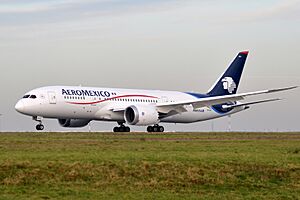
Current Fleet
As of July 2025, Aeroméxico uses only Boeing planes for its main flights. Here are the types of planes it has:
| Aircraft | In fleet | Orders | Passengers | Notes | |||
|---|---|---|---|---|---|---|---|
| J | Y+ | Y | Total | ||||
| Boeing 737-800 | 34 | — | 16 | 18 | 126 | 160 | |
| Boeing 737 MAX 8 | 42 | 3 | 16 | 18 | 132 | 166 | |
| Boeing 737 MAX 9 | 27 | 3 | 16 | 18 | 147 | 181 | |
| Boeing 787-8 | 8 | — | 32 | 9 | 202 | 243 | |
| Boeing 787-9 | 14 | 2 | 36 | 27 | 211 | 274 | One plane (XA-ADL) has a special Quetzalcoatl paint design. |
| Total | 125 | 8 | |||||
This list does not include the planes used by its regional airline, Aeroméxico Connect.
Former Fleet
Aeroméxico used to operate these types of aircraft:
- Avro Anson
- Bellanca Pacemaker
- Beechcraft 17 Staggerwing
- Boeing 247D
- Boeing 737-700
- Boeing 757-200
- Boeing 767-200ER
- Boeing 767-300ER
- Boeing 777-200ER
- Bristol Britannia
- Convair 340
- Douglas DC-3
- Douglas DC-4
- Douglas DC-6
- Douglas DC-8
- Lockheed Constellation
- McDonnell Douglas DC-9-15
- McDonnell Douglas DC-9-30
- McDonnell Douglas DC-10-15
- McDonnell Douglas DC-10-30
- McDonnell Douglas MD-82
- McDonnell Douglas MD-83
- McDonnell Douglas MD-87
- McDonnell Douglas MD-88
- Stinson SR
- Travel Air
Important Events and Incidents
- March 26, 1954: A Douglas DC-3 plane had an incident near Monterrey, Mexico.
- June 2, 1958: Aeronaves de México Flight 111, a Lockheed L-749A Constellation, crashed near Guadalajara, Mexico. This happened shortly after takeoff. All 45 people on board died.
- January 19, 1961: Aeronaves de México Flight 401, a Douglas DC-8-21, had an incident at Idlewild Airport in New York City.
- August 13, 1966: A Douglas DC-8-51 plane had an incident near Acapulco, Mexico.
- December 24, 1966: A Douglas DC-8-51 plane had an incident at Lake Texcoco, Mexico.
- June 12, 1967: A Douglas DC-3A plane had an incident near La Paz, BCS, Mexico.
Aerovías de México (Aeroméxico) Era
- June 20, 1973: Aeroméxico Flight 229, a Douglas DC-9-15, crashed into a mountain near Puerto Vallarta, Mexico. All 27 people on board died.
- September 2, 1976: Aeroméxico Flight 152, a Douglas DC-9-15, went off the runway at León, Guanajuato-Del Bajío Airport. The plane was badly damaged, but no one was hurt.
- November 11, 1979: Aeroméxico Flight 945, a DC-10, had a problem over Luxembourg. The plane lost a lot of altitude. It landed safely in Miami, and no one among the 311 people on board was injured.
- July 27, 1981: Aeroméxico Flight 230, a Douglas DC-9-32, crashed while landing in Chihuahua. Some people on board died.
- November 8, 1981: Aeroméxico Flight 110, a Douglas DC-9-32, crashed in the mountains of Guerrero state.
- August 31, 1986: Aeroméxico Flight 498, a McDonnell Douglas DC-9-32, collided with a small plane over Cerritos, California, while approaching Los Angeles International Airport. Everyone on both planes died, along with some people on the ground. An investigation found that the pilot of the small plane had flown into an area where it should not have been.
- October 6, 2000: Aeroméxico Flight 250, a Douglas DC-9-31, went off the runway at General Lucio Blanco International Airport, Reynosa, Mexico. Four people on the ground died.
- September 9, 2009: Aeroméxico Flight 576 was hijacked between Cancún and Mexico City. The hijacking ended in Mexico City with no injuries.
- May 20, 2017: Aeroméxico Flight 642, a Boeing 737-800, hit a utility truck at Los Angeles International Airport. Eight people were injured.
- July 31, 2018: Aeroméxico Connect Flight 2431 crashed during takeoff from Durango International Airport. The plane lost speed and hit the runway. It caught fire and was destroyed. All 103 people on board survived, but 39 were injured.
- January 5, 2023: Aeroméxico Connect Flight 165, an Embraer 190, stopped its takeoff from Culiacán International Airport after being hit by a bullet. The plane had a hydraulic system problem, but all passengers and crew were uninjured. This happened during clashes between Mexican forces and criminal groups near the airport.
See also
 In Spanish: Aeroméxico para niños
In Spanish: Aeroméxico para niños
- Airports and air travel in Mexico
- List of companies of Mexico
- Transportation in Mexico


